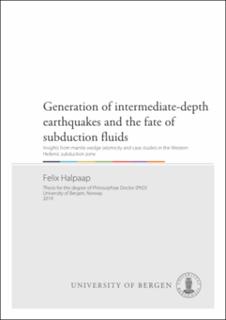| dc.contributor.author | Halpaap, Felix | |
| dc.date.accessioned | 2019-12-05T13:50:08Z | |
| dc.date.available | 2019-12-05T13:50:08Z | |
| dc.date.issued | 2019-06-07 | |
| dc.date.submitted | 2019-10-22T00:15:07Z | |
| dc.identifier | container/f2/0a/6f/d0/f20a6fd0-4948-4d5c-a799-f32e9f197c33 | |
| dc.identifier.uri | https://hdl.handle.net/1956/21059 | |
| dc.description.abstract | The occurrence of intermediate depth earthquakes at 50-300 km depth in subduction zones is puzzling, because high temperatures and pressures at these depths do not allow standard brittle failure. Instead, two main candidate mechanisms have been proposed: dehydration embrittlement and localized thermal shear runaway. It is highly debated which of these two mechanisms is the dominant one, and how the two mechanisms may combine to explain the different styles of seismicity observed in the various parts of subduction systems. While dehydration embrittlement requires that hydrated minerals undergo a phase transition to provide a free fluid phase, shear runaway may occur under dry conditions but within restricted pressure-temperature conditions. These different premises should allow the mechanisms to be distinguishable based on the thermal-petrologic conditions under which earthquakes occur, as these conditions vary significantly between different parts of the subduction system. However, the resolution of seismic images and standard hypocenter solutions do not usually allow earthquakes to be robustly located in relation to the discontinuities outlining the different domains of the subduction system (e.g., subduction interface and slab Moho). This thesis provides new insight into what generates intermediate depth earthquakes. The work is divided in three parts: (I) a traveltime tomography study, which recovers the outline of the subducting crust and the location of earthquakes in the Western Hellenic subduction zone, (II) a combined seismological-geodynamic investigation, which links intraslab earthquakes to the little-known phenomenon of mantle wedge seismicity, and (III) the development of a new method that helps constrain earthquake locations relative to subduction discontinuities. Part I investigates the south-to-north transition from oceanic to continental subduction in the Western Hellenic subduction zone. The goal is to see how this transition affects fluid release and related seismicity along strike. Although the northern and southern trenches are offset, seismicity and tomographic images show a smooth transition between slab retreat and slab convergence from south to north. Relocated hypocenters outline a single-planed Wadati-Benioff Zone with significant along-strike variability, including an abrupt termination toward the transition to continental subduction. Seismic anomalies point to fluid-related metamorphism in three parts of the system: eclogitization of the crust near 90~km depth, subarc melting of the mantle below the volcanic arc, and large-scale silica enrichment in the lower part of the overriding crust. Part II examines the cause of mantle wedge seismicity clusters, and why the subducting crust updip of these clusters is aseismic. Newly detected and relocated earthquakes, focal mechanisms, and thermal-petrologic models reveal that earthquakes effectively track the flow of fluids from their slab source at >80 km depth to their sink at shallow (<40 km) depth. Between source and sink, the fluids flow updip under a sealed plate interface, facilitating intraslab earthquakes. In some locations, the seal breaks and fluids escape through vents into the mantle wedge, thereby reducing the fluid supply and seismicity updip in the slab. The vents themselves may represent nucleation sites for larger damaging earthquakes. Part III develops a new seismic processing workflow to enhance and analyze secondary phases of local earthquakes. Secondary phases include seismic wave reflections and conversions that provide information on the earthquake location relative to the discontinuities. The workflow comprises rotation, alignment, bandpass- and polarization-filtering, optimized sorting and plotting of three-component seismograms in station gathers, followed by a comparison with theoretical arrival times of relevant phases. Each station gather exhibits on average two to three secondary arrivals, some of which independently confirm earthquake sources in the mantle wedge and on the plate interface. Taken together, the three parts of the thesis shed new light into how a cold slab undergoes metamorphism and releases water with depth – two processes that cause melting below the arc, establish pathways for fluid-induced earthquakes in the system, and contribute to chemical enrichment of the lower crust and mantle wedge. | en_US |
| dc.language.iso | eng | eng |
| dc.publisher | The University of Bergen | en_US |
| dc.relation.haspart | Paper I: Felix Halpaap, Stéphane Rondenay, Lars Ottemöller, 2018. Seismicity, Deformation and Metamorphism in the Western Hellenic Subduction Zone - New Constraints from Tomography, Journal of Geophysical Research: Solid Earth 123(4), 3000-3026. The article is available at: <a href="http://hdl.handle.net/1956/19128" target="blank">http://hdl.handle.net/1956/19128</a> | en_US |
| dc.relation.haspart | Paper II: Felix Halpaap, Stéphane Rondenay, Alexander Perrin, Saskia Goes, Lars Ottemöller, Håkon Austrheim, Robert Shaw, Thomas Eeken, 2019. Earthquakes track subduction fluids from slab source to mantle wedge sink, Science Advances 5(4), eaav7369. The article is available at: <a href="http://hdl.handle.net/1956/19865" target="blank">http://hdl.handle.net/1956/19865</a> | en_US |
| dc.relation.haspart | Paper III: Felix Halpaap, Stéphane Rondenay, Qinya Liu, Florian Millet, Lars Ottemöller, 2021. Toward Waveform-Based Characterization of Slab & Mantle Wedge (SAM) Earthquakes, Journal of Geophysical Research: Solid Earth 126(9), e2020JB021573. The article is available at: <a href="https://hdl.handle.net/11250/2975921" target="blank">https://hdl.handle.net/11250/2975921</a> | en_US |
| dc.rights | Copyright the Author. All rights reserved | eng |
| dc.title | Generation of intermediate-depth earthquakes and the fate of subduction fluids : Insights from mantle wedge seismicity and case studies in the Western Hellenic subduction zone | en_US |
| dc.type | Doctoral thesis | |
| dc.date.updated | 2019-10-22T00:15:07Z | |
| dc.rights.holder | Copyright the Author. | en_US |
| dc.contributor.orcid | https://orcid.org/0000-0002-8291-269X | |
| dc.identifier.cristin | 1757214 | |
| fs.unitcode | 12-50-0 | |
